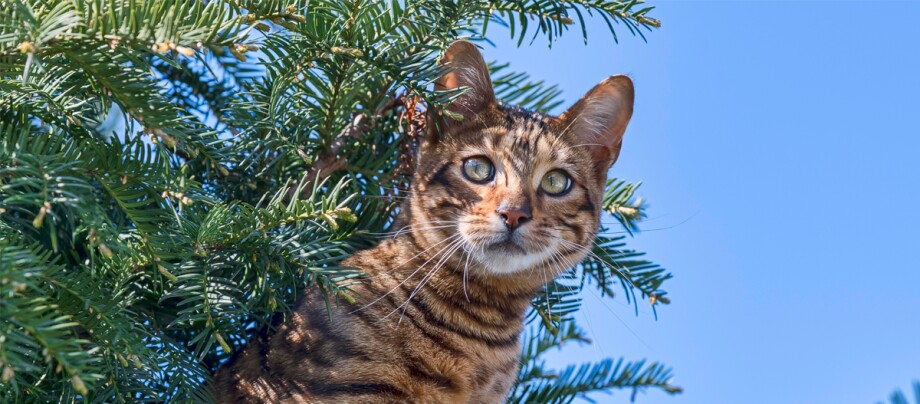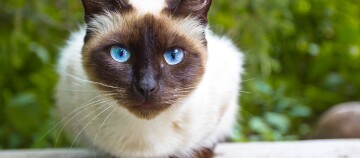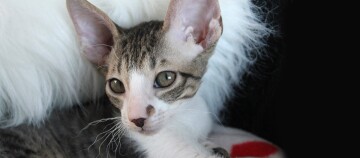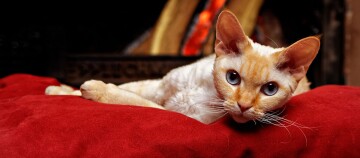Toyger - Fall in Love with This Intelligent and Cuddly Mini Tiger
01.01.2024 - Reading time: 4 minutes

House cat doesn’t really seem like the right name here: the Toyger is a breed that is meant to look as much like their imposing role model from the jungle as possible. Their distinctive striped pattern immediately catches the eye. Per the definition, this is a “designer cat” intended to produce the desired appearance through selective mating. But these agile cats are much more than just beautiful and exotic: under their tiger fur is a playful, lovable feline.
NewsletterToyger
Breed | Toyger |
Origin | USA |
Size | average size, about 50 cm head to torso length, up to 36 cm shoulder height |
Weight | 4.5 kg (males), 3.5 kg (females) |
Physique | elongated, athletic and muscular, broad chest, average length legs, strong paws |
head shape | long and wide, small ears |
Eyes | round, deep-set; yellow or green |
Coat and colour | short hair, brown tabby markings |
Coat care | occasionally groom with animal hair brush |
Nature | intelligent, playful, devoted, self-assured, even-tempered |
Special features | sharply defined, high-contrast tiger markings |
Owning | Keeping a cat indoors – balcony with cat safety device expressly recommended |
Toyger: Nature
Although you would never suspect it from its wildcat look, the Toyger is anything but unapproachable. It is a true pussycat that wants care and affection from its owner and generally gets along with children and dogs. The Toyger cat is exceptionally cunning.
It needs mental challenge in the form of intelligent toys – they are ideal candidates for cat agility or clicker training. Children who know how to play with cats find the Toyger to be a wonderful companion. In addition, the animals impress with their self-assured and even-tempered manner. They rarely play the slighted diva and are not resentful when something doesn’t go their way.
Keeping and caring for the Toyger
No particular predisposition for inherited diseases is known for Toyger cats. They are actually considered to be quite robust. Their care presents no special challenge to the owner: just comb their short, thick fur now and then. They are bred to be house cats, therefore Toygers are the ideal house pets for a home in the city, and enjoy a safe balcony or garden.
Even though they don’t have a ravenous need for freedom, these small tigers are very powerful. They want action and diversity. Abundant playtime with their humans is a must.
Toyger colours
The only permissible colouring for the Toyger is a brown-striped tabby pattern with grey, brown and chocolate coloured hair and a reddish-orange base tone. There are efforts to establish other base colours (so-called “Snow” and “Silver Toyger” with white/grey base colour). The stripes should be closed as much as possible with random elongations running through them; in technical jargon you call it a mackerel pattern. Many Toygers have a lighter stomach and white inner thighs, just like their wild cousin from Asia.
The history of the Toyger
A cat that looks like a tiger on the outside – this was the breeding goal of cat lover Judy Sudgen in the early 1990s. Through selective mating, she wanted to strengthen the tabby pattern in such a way that it continued in the face and to the legs. To do so, Sudgen simulated possible crossbreeding results of different cat breeds on a computer.
The progenitors of the breed were a Bengal cat and a “typical” American tabby shorthair. In 1993 a street cat from India introduced its spotted ears into the gene pool. Since 2007 the breed has been officially recognized as the “California Toyger”, however so far only by the American Association of the International Cat Association (TICA).
Now there are also Toyger breeders in Germany. The purebred cat is high-priced: fancier cats – animals that cannot be used as breeding animals because of a small deviation from the breed standard, such as unwanted markings – cost about EUR 1,300, while breeding specimens cost significantly more.
Special characteristics of the Toyger
Toygers are striped from their head to the tip of their tail. Unlike a traditional tabby cat, the tiger stripes do not become blurred as they approach the head and paws, but instead are clearly defined. The fur is usually notably thick, which gives them a soft and plushy texture. An additional characteristic feature is their high intelligence: the cats always need new challenges, but are domesticated and do not absolutely require time to roam free outdoors. By the way, unlike the typical cat, many Toygers are not the least bit afraid of water.





